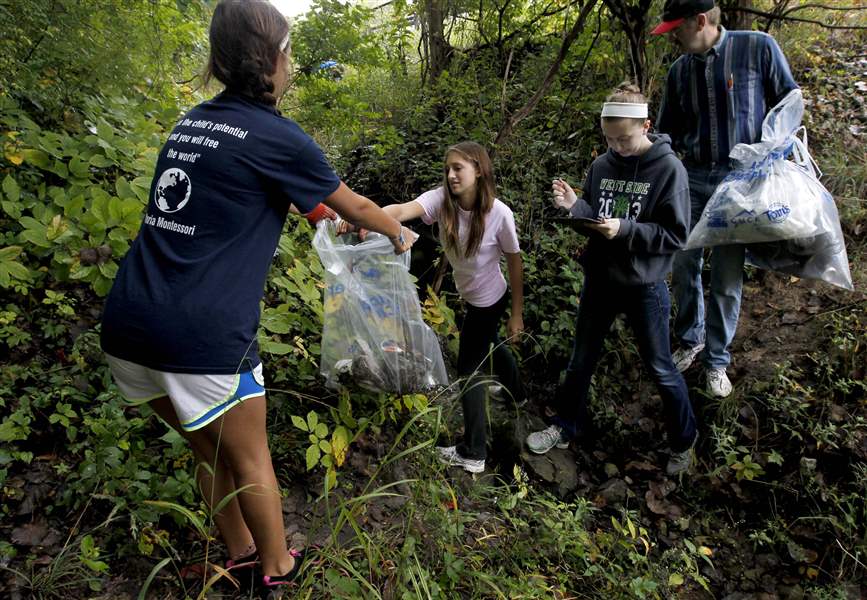
OUTDOORS
Commentary: Volunteers purge trash from water
10/7/2014
Westside Montesorri students from left Maddy Vesoulis, Jami Stout, Katherine Bauer and her father Dave Bauer clean trash from a stream.
The Blade/Lori King
Buy This Image

Westside Montesorri students from left Maddy Vesoulis, Jami Stout, Katherine Bauer and her father Dave Bauer clean trash from a stream.
The recent “Clean Your Streams” day was a wonderful display of the immediate environmental impact a battalion of volunteers can have right in our collective neighborhood.
The event also provided a harsh commentary on the least of us, and the lack of respect this element of society has on what many of us hold so precious — our water.
While we pass out kudos and salute the more than 1,100 volunteers who scoured our waterways and removed nearly 17,000 pounds of trash, we simultaneously cast shame on those slovenly individuals who thought it acceptable to use these waters as their trash heap.
PHOTO GALLERY: ’Clean Your Streams’ Day
As part of International Coastal Cleanup Day, the volunteers fanned out across the region and cleaned the banks and the channels of the Maumee and Ottawa rivers, as well as Swan Creek, Otter Creek, Grassy Creek, and an assortment of other threads and fibers of water.
The fact they rolled up their sleeves, put on their old sneakers and some insect repellant, and sent so much crud to the landfill should delight you. What they pulled out of those rivers and streams should thoroughly disgust us all.
In the big and really ugly department, there were 126 tires pulled out of the water, and after being recycled they hopefully will end up as a safety mat on a playground.
There was also the sad roundup of all of the usual suspects — the ones we see in great numbers in our parks and public areas and on our riverbanks — plastic bottles, food wrappers, drinking straws, and cigarette butts.
The volunteers also encountered a puzzling array of rubbish, detritus, spilth, debris, effluvium, and dreck, and very little of what is actually flotsam and jetsam, as they removed unsightly and sometimes dangerous items from waterways in Toledo, Oregon, Sylvania, Perrysburg, and Maumee.
There were construction materials, lottery cards, a butter knife, a turtle trap, Christmas lights, firecrackers, an anchor, a vending machine door, a purple velvet cape, and a Teletubbie doll that was missing its eyes.
The list, which sounds like what’s left from a poorly organized garage sale or the residue from a fire at a storage facility, also included boat parts, a full six-pack of beer, a 1988 Faygo Ginger Ale can, a pair of boxer shorts, a kiddie swimming pool, a lobster crate, a fire pit, and a Confederate flag.
All of this trash was tossed in the water, discarded along the banks, carried by the wind, or rerouted somewhere along the river systems. It could have ended up in Lake Erie, where many of us fish, boat, and get our drinking water.
The volunteer force that marched into these waterways lacked the torches and pitchforks of a good peasant army, but it came equipped with plenty of energy and passion, according to Ava Slotnick, the outreach coordinator with the Perrysburg office of Partners for Clean Streams.
“We have a very small staff, but we are responsible for a lot of rivers, so we need people to help out with a project of this size. You can get an awful lot done when you have over a thousand people pitching in,” she said.
Slotnick said the waterway cleanup has benefits that go well beyond taking tons of trash out of these streams.
“You are cleaning up these rivers, but at the same time you are also building a community of caring individuals, building pride in our community, and also getting many of these people down to the river for the first time,” she said.
“There is certainly a lot of environmental benefit, but there’s a lot education taking place too. This connects people with their water, and they drink this water, so it’s beneficial for them to help take care of it.”
Contact Blade outdoors editor Matt Markey at: mmarkey@theblade.com or 419-724-6068.